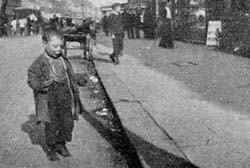Poverty and Juvenile CrimeThe first part of this article looks at the life of child criminals. Part
2 looks at prisons and the sort of treatment child prisoners received.
Juvenile criminals In the 19th century children living on the streets or those living in overcrowded housing with little or no parental care, had to find some way of staying alive. Many of them drifted into crime. They often did not know that what they did was wrong. They were destitute of all those things that children should have as a right - food, clothing, shelter, security and care. James Greenwood, an investigative journalist wrote, '...they have an ingrained conviction that it is you who are wrong, not them. That you are wrong in the first place in appropriating all the good things the world affords, leaving none for them but what they steal.'(1) Destitution leads to crimeJames Greenwood reported in 1869, 'How the information has been arrived at is more than I can tell; but it is an accepted fact that, daily, winter and summer, within the limits of our vast and wealthy city of London, there wander, destitute of proper guardianship, food, clothing, or employment, a hundred thousand boys and girls in fair training for the treadmill and the oakum shed, ...' (2) The recurring theme seems to be that crime and homelessness were indelibly linked. Time and time again people were saying that if only the destitute children could be rescued from the streets a large part of the problem of juvenile crime would be solved. Child gangsSometimes children became part of gangs controlled by adults. They were taught how to steal and bring the stolen goods back to their 'protector' who then acted as the 'fence' for the stolen property. The young thief was sometimes given a small percentage of the money gained. These adults were the 'Fagin like' characters portrayed so graphically by Charles Dickens in his novel Oliver Twist .
The pickpocketHenry Mayhew was a journalist who wrote a series of articles for a daily newspaper about the way the poor people of London lived and worked. One young pickpocket told him his story . He was an orphan and was dismissed from the pottery where he worked. He could not obtain another job and after losing some of his few possessions he met up with a gang of boys in a similar circumstance to himself. He said he was a good pickpocket and that he would rather steal from the rich than the poor because 'they miss it less'. He also said that 'Picking pockets ... is the daringest thing that a boy can do'(3). The boy had been in prison thirteen times and flogged four times. However it did not teach him the error of his ways. 'Every time I came out harder than I went in' (4). Once a child had started on the criminal ladder peer pressure then kept him there. In prison there was a criminal hierarchy. The young pickpocket said that if you were in prison for begging you would be laughed at. 'Begging! Oh, you cadger!' so he said that 'a boy is partly forced to steal for his character' (5). To Poverty and Juvenile Crime Part 2 - Prisons References1. James Greenwood, The
seven curses of London 'Juvenile thieves', p. 2 (London: Stanley
Rivers, 1869) |





